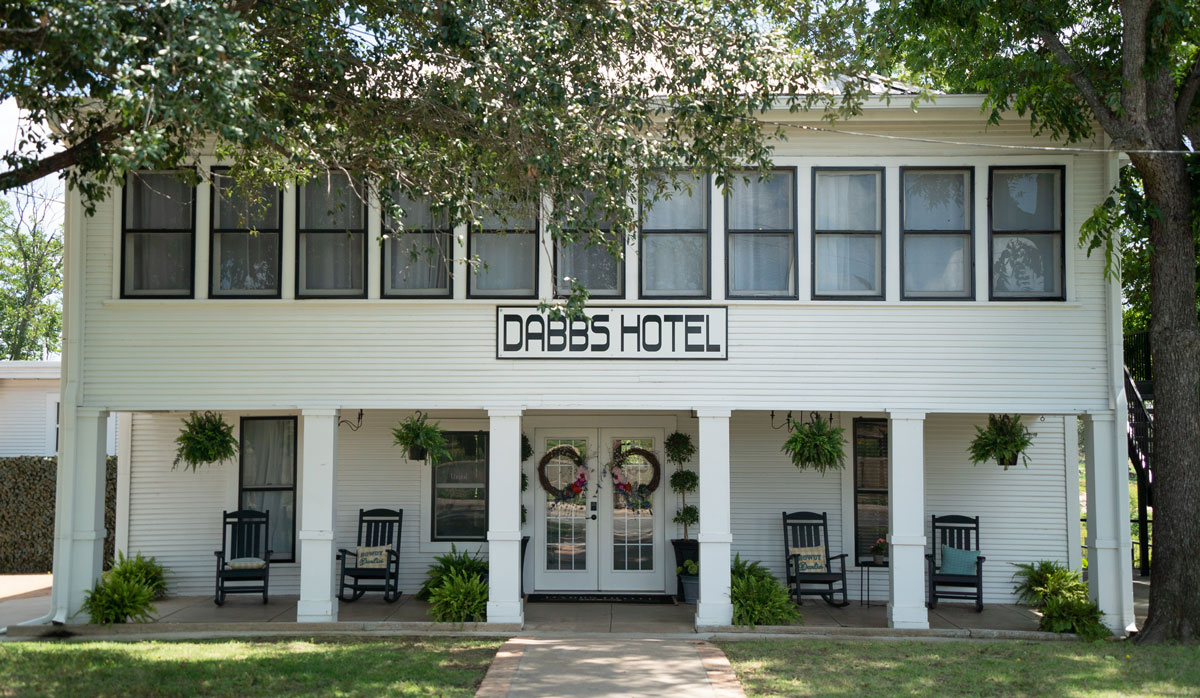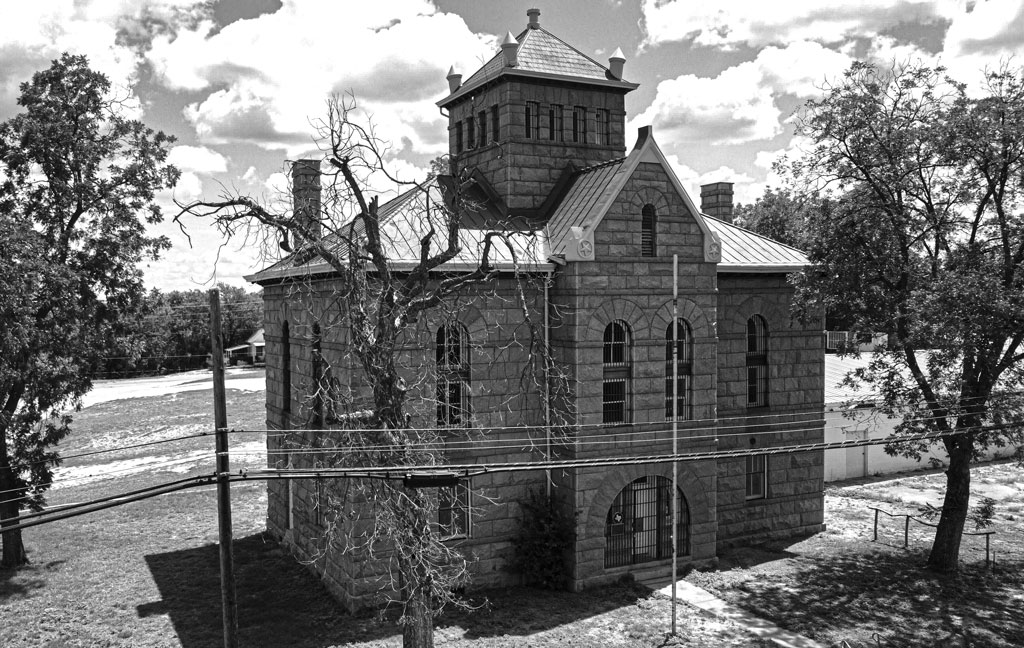
The Llano County Courthouse in the center of downtown Llano adds to the city’s historic aesthetic. Staff photo by Dakota Morrissiey
“You can almost see the wagons and horses going down the streets.”
These were the words of Kim Webb, a multi-hatted Llano local who dispenses information for the Llano Visitor Center and Chamber of Commerce. She was talking about the granite-boned, former Wild West town that is currently experiencing a business boom.
New shops, bars, and restaurants are popping up like bluebonnets in spring all over the city, but this isn’t the first time that’s happened. A stroll through downtown Llano will take you back to the small Texas Hill Country city’s frontier past and into its prosperous present.
“At one time, there were 22 saloons here,” Webb told 101HighlandLakes.com. “The population of Llano was between (8,000) and 10,000 people. It was a swinging town.”
Today, Llano has about 3,400 people. But back then, saloons, hotels, and dance halls accommodated a cast of Wild West characters that would be right at home in a John Wayne picture. A courthouse and formidable jail were built to keep that same cast of characters in line, and both are still standing today. A Western history aficionado would have a field day roaming the streets of Llano, examining the 19th century architecture and diving into the lore of the 1890s mineral boom that put the town on the map.
Having said that, you don’t need to be a history buff to appreciate the depth of Llano’s past. Just knowing a little can add a layer of fun to a short visit, day trip, or relaxing weekend by the Llano River.
We’ve laid out Llano in three must-see sections below:
THE RAILYARD DISTRICT

The Llano Visitor Center, 100 Train Station Drive, is the best place to start if you want historic background. It’s also located in the city’s former railyard and within walking distance of a few cool spots. Attached to the center are a small railroad museum and mining exhibit that will brief you on Llano’s industrious past. Outside are a replica platform, train cars and tracks, and a garden that you can explore — all photo-worthy.

Take a short walk from the visitor center to the Dabbs Hotel, which has been in business since 1907 when guests would hop off of the train for a stay. Local legend says the Dabbs was a favorite hangout for the infamous 20th century outlaw couple Bonnie and Clyde. If you’re not staying the night, grab lunch at the hotel and enjoy the view of the Llano River before taking a quick trip by foot to the downtown area for shopping.

Go on a deep dive into the region’s past at the Llano County Historical Museum, 310 Bessemer Ave. What sets this museum apart is that its collection is so close to home. Almost everything inside was donated by the old families who have been in Llano since it was founded in 1856. A visit is more like peeking at somebody’s treasured keepsakes rather than a staid perusal of stuffy exhibits at a traditional museum. The collection extends outdoors to an authentic log cabin, the oldest extant structure in Llano. It was built in 1860 but later disassembled from its original site up river and brought into town to be put on display.
THE NORTH SIDE

The Llano River cuts the town into northern and southern halves, which are connected by the Roy B. Inks Bridge. The meat of the city, including the Llano County Courthouse square, is on the south side, but the north side has some worthwhile historical gems. The Badu building, 507 Bessemer Ave., was built in 1891 and functioned as the town’s banking center — the “Wall Street” of Llano, it was affectionately called. It soon became the home of eccentric mineralogist N.J. Badu, who was a driving force behind Llano’s mineral boom. Since then, the Badu building has housed a parade of hotels and restaurants. It is currently closed and for sale if you’re in the market for a ritzy, potentially haunted, 19th century granite fortress.
Grab a croissant or kolache at the stucco-coated Chrissy’s Bakery, 501 Bessemer Ave., which used to be the 1910 headquarters of the long-gone Cassaday Grey Granite Company. Pretty much everything in Llano once served the mineral industry, which was responsible for the railroad coming to town and the subsequent flock of folks looking for opportunity.
The buildings at 301, 303, and 305 Bessemer Ave. functioned as grocery and drug stores throughout the early 1900s. Now, you can find a swanky local bar, The Falls, in what used to be Bruhl Drug Store at 305 Bessemer. Nearby, in the empty space between the bar and the river, once stood Barker’s Casino, which burned down. The casino was the epicenter of entertainment, famous for its indoor skating rink and greased pig catching contests. (It is unknown if anyone in town has proposed bringing back greased pig catching as an attraction.)
Honorable historical mention goes to the building at 105 W. Grayson St., which now houses SOAR Health Club, a surprisingly luxurious, 24-hour fitness center, but was once a storage site for furs and groceries.
THE SQUARE

Llano’s downtown doesn’t feel so far removed from the Old West. Whether or not you’re seeking it, history is omnipresent and undeniable when you walk around the square. The looming Llano County Courthouse, built in 1893, is still the functioning heart of government. Even the sidewalks are remnants of bygone days. The Visitor Center’s Webb explained that the raised walks and high steps across the city were built to accommodate the loading and unloading of horse-drawn wagons. This is most evident near Fuel Coffee House, 106 E. Main St., which was Watkins Grocery Store about 130 years ago.

Back in 1922, Ford Motor Company was based out of 122 E. Main St., now War Trail Spirits, a new distillery. Those enjoying their drinks on the distillery’s deck can see the Red Top Jail looming in the distance. Located at 400 Oatman St., it is one of the most iconic structures in Llano. Book a tour and see the guts of the 1895-built lockup or admire its formidable architecture from afar.
Downtown is riddled with dozens of historical markers, buildings, and stories. It’s said that outlaw Johnny Ringo was locked up in a subterranean jail that used to be next door to the LanTex Theater, 113 W. Main St. A now-derelict building on Ford Street was once The Blood Bucket, a shady dancehall in the 1930s. At 110 E. Main St. stands the first commercial building in Llano, a grocery store opened by John Oatman in 1857. Now, it’s home to the trendy Texana Outfitters.
The city of Llano has over 130 years of frontier history embedded in its streets and structures. Take the time to go back in time on your next visit.
Browse the Highland Lakes History and Haunted Highland Lakes guides for more blasts from the past.









